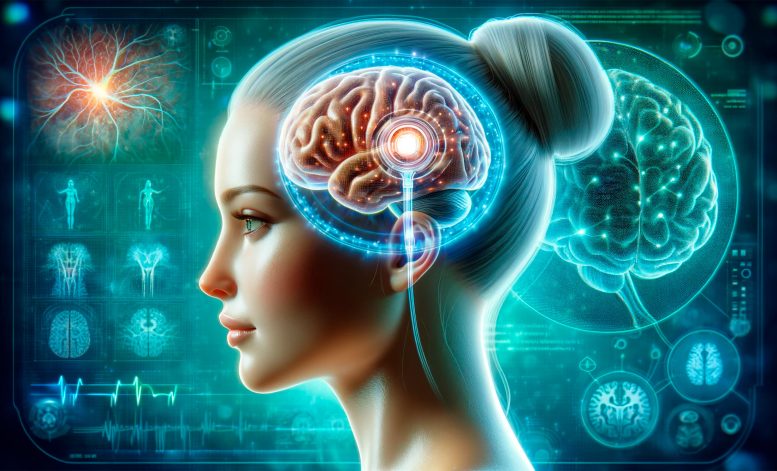
A Stanford Medicine clinical trial using deep brain stimulation offers new hope for people with moderate to severe brain injuries. The treatment significantly improved cognitive functions and activities of daily living, showing an improvement in brain injury treatment.
A new technique that uses deep brain stimulation tailored to each patient has exceeded researchers’ expectations in treating mild to severe traumatic brain injury for cognitive deficits.
In 2001, Gina Arata was in her final semester of college, planning to apply to law school, when she suffered a traumatic brain injury in a car accident. The injury compromised her ability to focus, and she struggled with a job sorting letter.
“I don’t remember anything,” said Arata, who lives with his parents in Modesto. “My left leg fell off, so I was holding on to things all the time. I was always in car accidents. And I have no filter – I get angry very easily.
Her parents reached out after learning about research being conducted at Stanford Medicine; Aratha was accepted as a participant. In 2018, doctors surgically implanted a device into his brain and then carefully calibrated the device’s electrical activity to stimulate injury-suppressing networks.

After suffering a brain injury in a car accident, Gina Arata could not concentrate enough to study. A device implanted in her brain has improved her ability to focus, her memory and her mood. Credit: Courtesy of Aratha Family
She noticed the difference right away: When she was asked to list the ingredients in the produce aisle of a grocery store, she could sort through the fruits and vegetables. Then a researcher turned off the device, and she couldn’t name anything.
“I haven’t had a speeding ticket since the implant,” Arata said. “I don’t travel anymore. I can remember how much money I have in my bank account. I can’t read, but after the implant I bought a book. A place where crawdads sing, and loved and remembered it. And I’m not so quick to anger.”
Breakthrough in brain injury treatment
For Arata and four others, the experimental deep-brain-stimulation device restored to varying degrees the cognitive abilities they had lost to brain injuries years earlier. The new technique, developed by Stanford Medicine researchers and collaborators from other institutions, is the first to show promise against long-term deficits in moderate-to-severe traumatic brain injuries.
The results of the clinical trial were published in the journal on December 4 Natural Medicine.
Living with traumatic brain injury
More than 5 million Americans live with the lasting effects of moderate to severe traumatic brain injury — difficulty concentrating, remembering and making decisions. Although many recover sufficiently to live independently, their disabilities prevent them from returning to school or work and resuming their social lives.
“Typically, there’s very little to treat these patients,” said Jaime Henderson, MD, professor of neurosurgery and co-senior author of the study.
However, the fact that these patients emerged from coma and recovered sufficient cognitive function, the brain systems that support attention and alertness – the ability to stay awake, focus on conversation and focus on a task – was relatively intact. protected.
Understanding and targeting the brain
These systems connect the thalamus, a relay station deep inside the brain, to points throughout the brain’s outer layer, which control more cognitive functions.
“In these patients, those pathways are mostly intact, but everything is down-regulated,” said Henderson, the John and Jean Bloom-Robert and Ruth Halperin Professor of Medicine. “It’s like the lights are dimmed and there’s not enough electricity to turn them back on.”

Jaime Henderson. Credit: Stanford Medicine
In particular, an area of the thalamus called the medial nucleus acts as a hub for regulating many aspects of consciousness.
“The medial lateral nucleus is primed to run things broadly, but the downside is that if you have a multifocal injury, it can have a greater impact because an impact can come from almost anywhere in the brain,” says Nicholas Schiff, MD. Weill Cornell Professor of Medicine and co-senior author of the study.
The researchers believed that precise electrical stimulation of the central lateral nucleus and its connections would reactivate these pathways and switch the lights back on.
Clinical trial success
In the trial, researchers recruited five participants with cognitive impairments lasting more than two years after a moderate to severe traumatic brain injury. They were 22 to 60 years old and had injuries three to 18 years ago.
Placing the stimulation device in the correct area is challenging and varies from person to person. Every brain is designed differently to begin with, and injuries lead to further changes.
“That’s why we’ve developed a number of tools to better define what that area is,” Henderson said. The researchers created a virtual model of each brain, which allowed them to pinpoint the location of activation of the central lateral nucleus and the level of stimulation.
Guided by these models, Henderson surgically implanted the devices in five participants.
“It’s important to precisely target the region,” he said. “If you’re even a few millimeters off target, you’re out of the effective zone.”
A pioneering moment
After a two-week titration phase to improve stimulation, participants spent 90 days running the device for 12 hours a day.
Their progress was measured with a standard test of mental processing speed called the Trail-Making Test, which involves drawing lines connecting a jumble of letters and numbers.
“It’s a very sensitive test of what we’re looking at: focus, focus and planning and doing it in a time-sensitive way,” Henderson said.
By the end of the 90-day treatment period, participants had improved their speed on the test by an average of 32%, which was more than the 10% the researchers were aiming for.
“The only surprising thing is that it worked the way we predicted, which is never a given,” Henderson said.
Impact on participants’ lives
For participants and their families, improvements were evident in their daily lives. They resumed activities that seemed impossible—reading books, watching TV shows, playing video games, or completing homework. They felt less tired and could go through the day without falling asleep.
The treatment was so effective that the researchers had trouble completing the last part of their study. They planned a blind withdrawal phase in which half of the participants would be randomly selected to turn off their devices. Two of the patients did not want to take that chance and declined. Of the three participants in the withdrawal phase, one was randomized to turn off their device. After three weeks without stimulation, that participant was 34% slower on the trail-making test.
Advanced brain injury therapy
The clinical trial is the first to target this area of the brain in patients with moderate to severe traumatic brain injury, and it gives hope to many who have plateaued in their recovery.
“It was a pioneering moment,” Schiff said. “Our goal now is to try to take systematic steps to turn this into a cure. That’s enough of a signal to make all the effort.
Note: Nicholas D. Schiff, Joseph D. Giacchino, Christopher R. Butson, Yoon Young Choi, Jonathan L. Baker, Kyle B. Sullivan, Andrew B. Johnson, Michael Bergin, Helen M. Bronte-Stewart, Jason Chua, Laurel DeGeorge, Sureya Digmen, Adam Fogarty, Linda M. Gerber, Mark Grell, Jose Maldonado, Matthew Radovan, Sudin Su Shah, Jadin A. , Nancy Temkin, Thomas Turdias, Jonathan D. Victor, Abigail Waters, Stephanie A. Kolakowski-Haner, Joseph J. Finns, Andre G. Machado, Brian K. Rudd and Jamie M. Henderson, 4 Dec 2023, Natural Medicine.
DOI: 10.1038/s41591-023-02638-4
Researchers at Weill Cornell Medicine, Spalding Rehabilitation Hospital in Boston, Harvard Medical School, University of Utah, University of FloridaVanderbilt University, The University of WashingtonThe University of Bordeaux and the Cleveland Clinic contributed to the study.
This study was supported by funding from the National Institutes of Health BRAIN Initiative and a grant from the Translational Science Center at Weill Cornell Medical College. Surgical implants were provided by Medtronic.